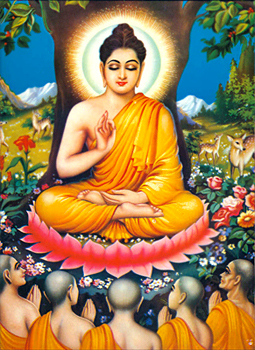 Hinduism in the age of Kalpasutras perceived the development of new religions like Jainism and Buddhism. This period extends from the birth of Lord Buddha to the decline of the Mauryan Empire. The kingdom of Magadha gained more prominence in the sixth century B.C. This period is also considered as the golden period of Buddhism. One gets an idea of religion in this period from the Srauta, Grihya, Dharma Sutras and the oldest portions of the Mahabharata. During this age sacrifices and beliefs in gods were intact. The varnas and ashrams were rigorously followed.
Hinduism in the age of Kalpasutras perceived the development of new religions like Jainism and Buddhism. This period extends from the birth of Lord Buddha to the decline of the Mauryan Empire. The kingdom of Magadha gained more prominence in the sixth century B.C. This period is also considered as the golden period of Buddhism. One gets an idea of religion in this period from the Srauta, Grihya, Dharma Sutras and the oldest portions of the Mahabharata. During this age sacrifices and beliefs in gods were intact. The varnas and ashrams were rigorously followed.
The orthodoxy of the priests was also retained. They organized their own class and their own rituals. They clung to the old and narrow conceptions of Dharma. There was no attempt to reorganize the institutions of the people in the light of the new universal religion. This period was very conservative.
The cult of the worship of images rose spontaneously when the Vedic sacrifices became elaborate and complicated. The Grihya-sutras which has the references to the new development became more important. However there arose several frauds who imitated the prophets of the Upanishads. They had put forth their own theories which confused the minds of the people with their false reasoning. True religion and morality were lost.
Under these circumstances Buddhism and Jainism arose which had a soothing effect on the confused public. These two religions had retained the ethical ideals of the orthodox religion. However they but rejected the authority of the Vedas and the superiority of the priests. Lord Buddha did not break away completely from the religious tradition of India. His teachings reiterated the thought of the Upanishads in a new manner.
Buddha`s teachings provided a remedy for the ills of life. He discouraged any questions which had no bearing on practical life. His teaching was restricted to Four Aryan Truths and the Eightfold Aryan Path. The Four Aryan Truths are: i) world is not free from sufferings, (ii) suffering has a cause, (iii) sufferings can be removed and (iv) there is a method to do this. The way is the famous eightfold path which if pursued leads one to nirvana which is the state of perfection reached by one when all desires and passions are conquered.
Jainism was the other religion which had witnessed its birth in this age. Jainism was more conservative. Jainism however did not spread beyond India. According to Jainism to attain nirvana there are three ways. However inspite of these developments Hinduism was never obscured by Buddhism or Jainism. Brahmanical Hinduism existed.




















